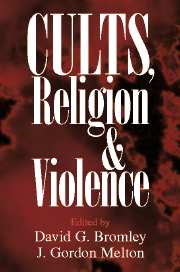Book contents
- Frontmatter
- Contents
- Acknowledgments
- Contributors
- Prologue
- 1 Violence and Religion in Perspective
- 2 Dramatic Denouements
- 3 Challenging Misconceptions about the New Religions–Violence Connection
- 4 Sources of Volatility in Religious Movements
- 5 Crises of Charismatic Legitimacy and Violent Behavior in New Religious Movements
- 6 Public Agency Involvement in Government–Religious Movement Confrontations
- 7 Watching for Violence: A Comparative Analysis of the Roles of Five Types of Cult-Watching Groups
- 8 Mass Suicide and the Branch Davidians
- 9 Occult Masters and the Temple of Doom: The Fiery End of the Solar Temple
- 10 Dramatic Confrontations: Aum Shinrikyô against the World
- 11 Making Sense of the Heaven's Gate Suicides
- 12 Lessons from the Past, Perspective for the Future
- Index
- References
5 - Crises of Charismatic Legitimacy and Violent Behavior in New Religious Movements
Published online by Cambridge University Press: 09 July 2009
- Frontmatter
- Contents
- Acknowledgments
- Contributors
- Prologue
- 1 Violence and Religion in Perspective
- 2 Dramatic Denouements
- 3 Challenging Misconceptions about the New Religions–Violence Connection
- 4 Sources of Volatility in Religious Movements
- 5 Crises of Charismatic Legitimacy and Violent Behavior in New Religious Movements
- 6 Public Agency Involvement in Government–Religious Movement Confrontations
- 7 Watching for Violence: A Comparative Analysis of the Roles of Five Types of Cult-Watching Groups
- 8 Mass Suicide and the Branch Davidians
- 9 Occult Masters and the Temple of Doom: The Fiery End of the Solar Temple
- 10 Dramatic Confrontations: Aum Shinrikyô against the World
- 11 Making Sense of the Heaven's Gate Suicides
- 12 Lessons from the Past, Perspective for the Future
- Index
- References
Summary
There is a marked tendency for the popular media to emphasize the role of supposedly “manipulative and mad” charismatic leaders in the tragic events surrounding the deaths of members of new religious movements. The focus on the role of the leader, perhaps the only member of the group about whom there is some information, reflects both our age-old desire to personify evil and the dramatic requirements of telling a good story. Clearly, there is some truth to the presumption that the powerful leaders of these groups were instrumental in bringing about the violence. Equally clearly, however, the focus on the greed, lust, or mental instability of the leaders fails to explain adequately why so many people were willingly to place their fates so completely in their hands. Why would the faithful follow these seemingly deranged leaders to their death? For decades, the answer to this question hinged on assuming that the followers were the victims of systematic programs of “brainwashing” or “mind control.” But the empirical evidence acquired by scholars of religion has soundly discredited that assumption, so we must look elsewhere for answers (Dawson 1998: 102–127).
The dramatic and exceptional incidents of cult-related violence we have witnessed in the last several decades stem, as Robbins delineates in the previous chapter, from the convergence of many factors, both endogenous and exogenous. The impact of charismatic leaders is one of the constants of these incidents.
- Type
- Chapter
- Information
- Cults, Religion, and Violence , pp. 80 - 101Publisher: Cambridge University PressPrint publication year: 2002
References
- 27
- Cited by



